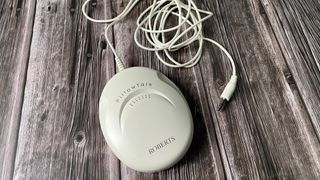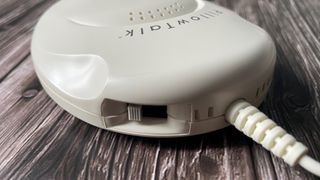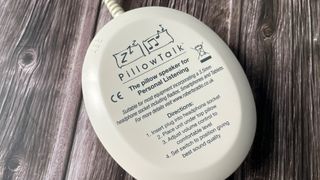TechRadar Verdict
Whether you want to doze off to gentle rainfall, soothing white noise, your favorite music, or an audiobook, the Roberts Radio Pillow Talk Speaker is the best option around. Unlike most under-pillow speakers, it renders detailed audio that doesn't sound muffled or muddy, even through a thick layer of down.
Pros
- +
Impressive audio quality
- +
No battery to overheat
- +
Slim design
Cons
- -
No in-line controls
- -
Non-functional settings switch
Why you can trust TechRadar
30-second review
This is the best under-pillow speaker we've tested to date, delivering surprisingly detailed sound even through a hefty layer of synthetic down. Roberts Radio is one of very few established audio companies making pillow speakers, and its decades of expertise really shine. Although it's simple, this little device is leagues ahead of the many similar-looking devices you'll find listed on Amazon.
The speaker has grilles on both the top and sides, which helps prevent the sound from becoming muffled, and although a pillow speaker is never going to offer audiophile quality sound, it's great for podcasts, gentle music, and ambient soundscapes when you settle down for the night. The audio from most pillow speakers tends to sound muddy, with higher frequencies all but lost, but that's not the case here.
It has a few design quirks (most noticeably the three-position switch on one side that doesn't appear to do anything), but it's nonetheless

Price and availability
The Roberts Radio Pillow Talk Speaker costs £14.99 (about $20 / AU$25), and is available internationally from third-party retailers like Amazon, or direct from Roberts in the UK (though at the time of writing it's out of stock at the company's online store).
That’s a mid-range price for a pillow speaker - the cheap and cheerful SoundLAB Pillow Speaker is around half the price, while the Sound Oasis Sleep Therapy Pillow Speakers are considerably more.
Design
The Roberts Radio Pillow Talk Speaker isn't an exceptionally attractive device, but that's not too important for a device that's hidden out of view. It's made from cream-colored plastic, and has an oval case measuring 100mm x 80mm x 26mm that sits neatly in the palm of your hand. It has speaker grilles on the edges and on top
The PillowTalk has no internal battery, which is an advantage for an under-pillow speaker. Lithium-ion batteries like those used in wireless Bluetooth speakers can overheat if covered (by a pillow, for example), which can be extremely dangerous and even lead to fires in some circumstances.

It has no Bluetooth transmitter, instead connecting to your phone (or other device) using a 3.5mm headphone plug attached to a 2m cable. This gives you more than enough slack to plug it into a device sitting on a bedside cabinet, while the speaker itself is nestled under your pillow.
Interestingly, there's a small switch on the side of the case, with positions labelled 1-3. The speaker's menu instructs users to choose the setting that provides the best sound quality, but there's no indication of what it actually does, and in our tests there seemed to be no discernible difference between the three. If the Pillow Talk Speaker was held together with screws, we'd have been tempted to disassemble it and check if it's connected to anything.

Performance
Many of the pillow speakers you’ll find online are anonymously made devices of dubious provenance and wildly variable quality, but not this one. Roberts Radio is a venerable audio company that’s been around since 1932, and it shows - this is easily the best sounding pillow speaker we’ve tested to date.
Audio is surprisingly detailed and crisp even through a thick pillow. This is partly down to the grilles on the side of the housing as well as on top - a smart design that helps avoid the sound being smothered. It's strange that the three-position switch on the side has no noticeable effect on the audio though, and Roberts doesn't describe what it's intended to actually do. It's certainly not a volume control.

Like most pillow speakers, there’s no lithium-ion battery here to risk overheating. Instead, the speaker simply connects to the headphone jack on your phone, MP3 player or (naturally) Roberts radio. This was fine when this speaker first went on sale, but now that many modern phones have no headphone socket, you might have to factor an adapter into the cost.
Its smooth plastic case means it can sometimes shift during the night, but you can help minimize this by tucking it inside your pillowcase, underneath the pillow. Otherwise, the design works well; it's so slim it's impossible to feel, even through a fairly thin pillow, and it's not uncomfortable if you tend to sleep on your hand.
There’s no in-line volume control, so you’ll need to reach for your phone in order to adjust the audio, but that’s a relatively minor quibble. Whether you want to fall asleep to the gentle patter of rain, a soothing podcast from the Calm app, or some relaxing music, this little speaker is ideal.

Buy it if
You enjoy audiobooks
Few pillow speakers do justice to speech, but Roberts Radio has pulled it off, and this little device will deliver clear narration right into your ear.
You've been considering sleep headphones
Sleep headphones are a great idea in theory, but rarely comfortable. You won't even feel this little speaker, and it won't leak sound and disturb your partner.
Don't buy it if
Your phone lacks a headphone jack
Like most pillow speakers, this one uses a standard 3.5mm connector, so you'll need to invest in an adapter.
You want to go wireless
If you don't want to run a cable from your pillow to your phone, you'll be better off with something like the Kokoon Sleepbuds, which use Bluetooth instead.
This article is part of TechRadar's Sleep Week 2022 (running from Sunday 13 to Saturday 19 March), a week-long celebration of all things slumber. We'll be bringing you proven techniques and tips to help you sleep better, and have rounded-up all the top-rated tech to transform your sleep.
Cat is the editor of TechRadar's sister site Advnture. She’s a UK Athletics qualified run leader, and in her spare time enjoys nothing more than lacing up her shoes and hitting the roads and trails (the muddier, the better)


